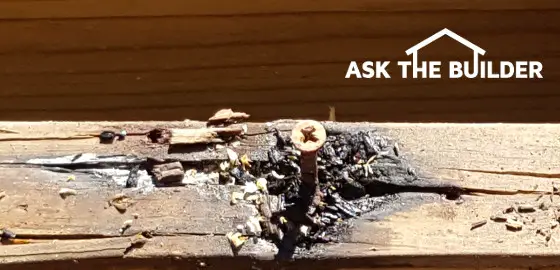Treated Wood Rot

This is a close-up shot of the top of a 2x10 treated wood deck joist. You can clearly see the rot happening around the corroding screw. (C) Copyright 2017 Tim Carter
Treated Wood Rot
DEAR TIM: I’m starting to have some rot issues with my ten-year-old deck. Not only are some of the treated wood decking boards having rot issues, but I’m also noticing that the tops of some of the joists are showing severe rot where the decking screws pass into the tops of the joists. The rot is 2 inches deep in a few of the joists! Is the lumber defective? Are the chemicals in the wood so strong as to cause the rot? What’s going on and is there anything that can be done to prevent it? Lawrence B., Concord, NC
DEAR LAWRENCE: I’ve experienced similar rot with treated lumber I’ve owned. Years ago, I built a treated wood play set for my kids. After fifteen years I got rid of it to build a garden shed for my wife.
I was shocked when I pulled the buried posts from the ground. Even though the lumber was rated for burial and direct contact with the soil, termites had consumed quite a bit of several posts.
Last year, I visited the home of a childhood friend and her treated lumber deck posts had severe rot where the end grain at the top of the posts was exposed to the weather and rain. A month after seeing this rot, I encountered some rot on my own treated lumber deck that I was rebuilding.
About twenty years ago, I was in the center of the vortex of a massive lawsuit between two giant corporations. I had Marvin Windows in my home that were treated with a defective clear wood preservative. While the windows were not made with the same species of wood as your deck, I have first-hand experience in knowing that treatment chemicals can be defective. Suffice it to say, treated wood does rot.
There are many reasons why it can happen. A defective pressure gauge at a treatment plant might be the culprit. The manufacturer of the chemical brew might have made a mistake in its testing procedures and the chemical may not perform as expected. Scientists in labs can and do make mistakes even though they try everything to prevent them. The list of possibilities is endless.
There’s a secondary issue that could be in play. When your deck was built, the carpenter could have unintentionally helped accelerate the rot. Base on the photo you sent to me, it’s quite obvious the top of the joist has a crack in it that extends back to the corroding screw.
This crack no doubt originated when the carpenter drove the screw through the decking into the top of the joist. Without drilling a pilot hole, the twisting screw produces enormous amounts of tension in the lumber as the mass of the screw pushes aside wood fibers.
I’ve never taken the time myself to drill pilot holes and I’ve never heard of a carpenter doing it as it’s so time intensive. I don’t want you to think it was his fault.
The crack may have been very small at the time the deck was built but over time the crack enlarged. This happens when water enters the crack and causes the wood to expand. When the wood dries out, the wood contracts. This back and forth movement can cause the crack to widen. As the crack gets bigger, the water drives deeper into the wood causing even more stress.
If the preservative chemicals didn’t penetrate deeply into the wood, then it stands to reason that the water entering around the screw in your photo can cause the wood to begin to rot.
Treated wood rot has spawned a new category of products to help protect your investment in the treated lumber and all the work to build a deck frame. You need three things to have wood rot: wood, water and fungi that eats the wood. If you take any of the three things away, you stop the rot.
Water is much easier to stop that trying to keep fungi away. Any number of products are available to stop water from entering the treated wood. Last year as part of my deck reconstruction project I applied a special tape on top of my wood joists before I installed the decking. This tape had a butyl rubber adhesive and is designed to seal around the shaft of the screws I used to attach the hidden fasteners for my decking.
You can also purchase rolls of ultra-thin stainless steel that also has the sticky butyl adhesive. Stainless steel is an excellent product to use to cover the tops and end grain of wood joists so that water can’t enter. It’s easy to cut the stainless steel with regular scissors and applying it is no different than using any other tape.
My advice to you is to replace any rotted pieces of treated lumber and then protect the top edge and any hidden end grain of the joists where they may get covered by a band board or butt up against a beam. Do this and you might end up with a deck frame that can last for many decades.
Column 1203